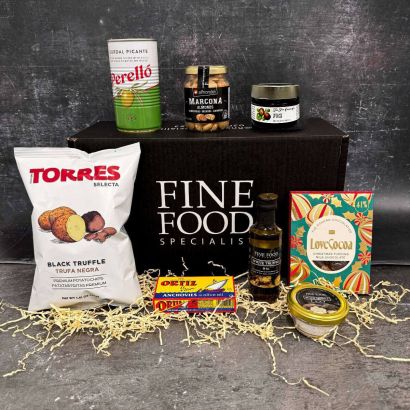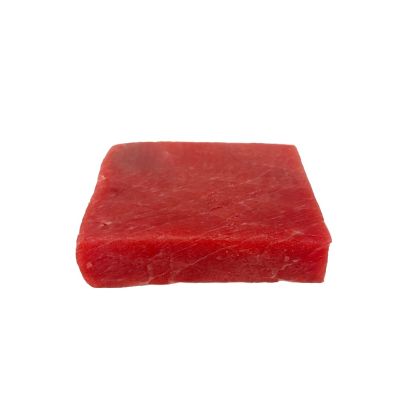 Bluefin Tuna 'Akami', Sashimi (Japan Grade), Saku Block, Frozen, +/-200g£26.95We have cut down our stunning Saku blocks in half to let you try this amazing fish. The Saku block are appropriately cut so that it is easy to slice and perfect for sushi. Bluefin tuna akami is next to the dorsal fin, which gives this part of the fish an intense red colour, due to its lower levels...
Bluefin Tuna 'Akami', Sashimi (Japan Grade), Saku Block, Frozen, +/-200g£26.95We have cut down our stunning Saku blocks in half to let you try this amazing fish. The Saku block are appropriately cut so that it is easy to slice and perfect for sushi. Bluefin tuna akami is next to the dorsal fin, which gives this part of the fish an intense red colour, due to its lower levels...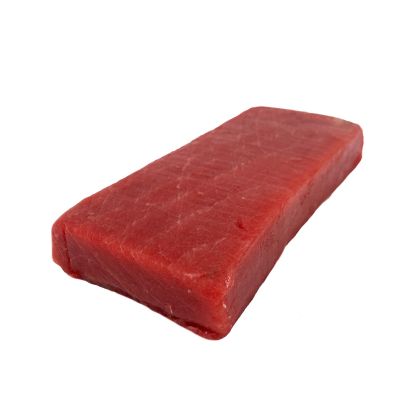 Bluefin Tuna 'Akami', Sashimi (Japan Grade), Saku Block, Frozen, +/-450g£55.95This stunning block of bluefin tuna askami is Japan grade sashimi, and comes in a Saku (Japanese term for block) so that it is the perfect shape to cut for sushi. Bluefin tuna akami is next to the dorsal fin, which gives this part of the fish an intense red colour, due to it's lower levels of fat th...
Bluefin Tuna 'Akami', Sashimi (Japan Grade), Saku Block, Frozen, +/-450g£55.95This stunning block of bluefin tuna askami is Japan grade sashimi, and comes in a Saku (Japanese term for block) so that it is the perfect shape to cut for sushi. Bluefin tuna akami is next to the dorsal fin, which gives this part of the fish an intense red colour, due to it's lower levels of fat th... Bluefin Tuna 'Otoro' Sashimi (Japan Grade), Saku Block, Frozen, +/-200g£31.95Bluefin tuna belly, or 'otoro' as it is also known in Japan, is one of the most highly sought after cuts of this special species of tuna. Only a small portion of it is available on each tuna, hence it's high price, but when it melts like butter in your mouth you will see why it is so sought after. T...
Bluefin Tuna 'Otoro' Sashimi (Japan Grade), Saku Block, Frozen, +/-200g£31.95Bluefin tuna belly, or 'otoro' as it is also known in Japan, is one of the most highly sought after cuts of this special species of tuna. Only a small portion of it is available on each tuna, hence it's high price, but when it melts like butter in your mouth you will see why it is so sought after. T... Bluefin Tuna 'Otoro' Sashimi (Japan Grade), Saku Block, Frozen, +/-400g£59.95Indulge in the exquisite taste of Bluefin Tuna 'Otoro' Sashimi (Japan Grade), Saku Block, a seafood delicacy that will captivate your palate. Renowned as the pinnacle of tuna cuts, the Bluefin tuna belly, or 'otoro' as it's known in Japan, is a highly sought-after gem. This toro fish rarity is due t...
Bluefin Tuna 'Otoro' Sashimi (Japan Grade), Saku Block, Frozen, +/-400g£59.95Indulge in the exquisite taste of Bluefin Tuna 'Otoro' Sashimi (Japan Grade), Saku Block, a seafood delicacy that will captivate your palate. Renowned as the pinnacle of tuna cuts, the Bluefin tuna belly, or 'otoro' as it's known in Japan, is a highly sought-after gem. This toro fish rarity is due t...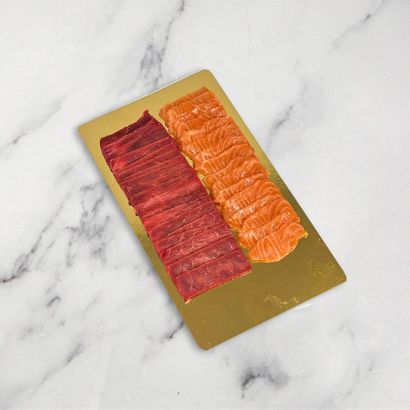 Bluefin Tuna 'Akami' & Salmon Sashimi Platter, Fresh, +/-300g£28.95Prepare to be captivated by our extraordinary Bluefin Tuna 'Akami' & Salmon Sashimi Platter, a culinary masterpiece that allows you to experience the finest cuts of Bluefin Akami tuna and premium salmon. At the heart of this stunning platter lies the Bluefin tuna Akami, meticulously sourced fro...
Bluefin Tuna 'Akami' & Salmon Sashimi Platter, Fresh, +/-300g£28.95Prepare to be captivated by our extraordinary Bluefin Tuna 'Akami' & Salmon Sashimi Platter, a culinary masterpiece that allows you to experience the finest cuts of Bluefin Akami tuna and premium salmon. At the heart of this stunning platter lies the Bluefin tuna Akami, meticulously sourced fro...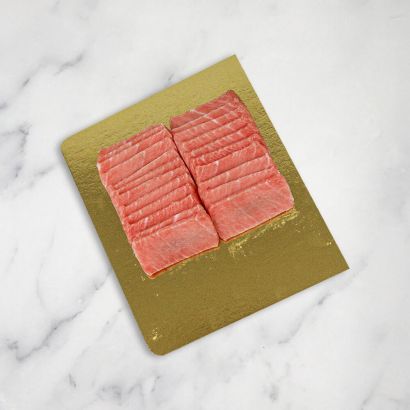 Bluefin Tuna 'Otoro' Sashimi Platter, Fresh, +/-150g£35.95Introducing our Bluefin Tuna 'Otoro' Sashimi Platter! Our platter features the finest selection of 'Otoro,' the most prized cut of Bluefin Tuna. Renowned for its rich marbling and melt-in-your-mouth texture, 'Otoro' is a delicacy reserved for those seafood lovers who truly appreciate the finer thin...
Bluefin Tuna 'Otoro' Sashimi Platter, Fresh, +/-150g£35.95Introducing our Bluefin Tuna 'Otoro' Sashimi Platter! Our platter features the finest selection of 'Otoro,' the most prized cut of Bluefin Tuna. Renowned for its rich marbling and melt-in-your-mouth texture, 'Otoro' is a delicacy reserved for those seafood lovers who truly appreciate the finer thin...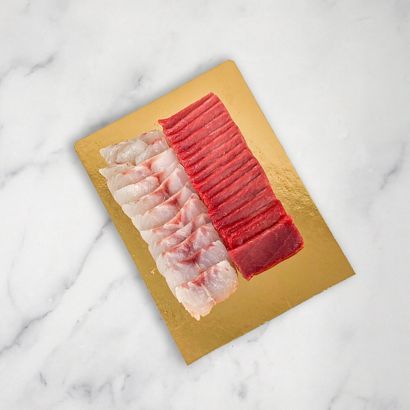 Bluefin Tuna 'Akami' & Sea Bass Sashimi Platter, Fresh, +/-300g£31.00Indulge in the Exquisite Bluefin Tuna 'Akami' & Sea Bass Sashimi Platter! Embark on a culinary journey with the Bluefin Tuna 'Akami' and Sea Bass Sashimi Platter! Bluefin tuna 'Akami' boasts a rich, buttery flavour with a hint of sweetness, while sea bass offers a delicate, mildly sweet taste. ...
Bluefin Tuna 'Akami' & Sea Bass Sashimi Platter, Fresh, +/-300g£31.00Indulge in the Exquisite Bluefin Tuna 'Akami' & Sea Bass Sashimi Platter! Embark on a culinary journey with the Bluefin Tuna 'Akami' and Sea Bass Sashimi Platter! Bluefin tuna 'Akami' boasts a rich, buttery flavour with a hint of sweetness, while sea bass offers a delicate, mildly sweet taste. ...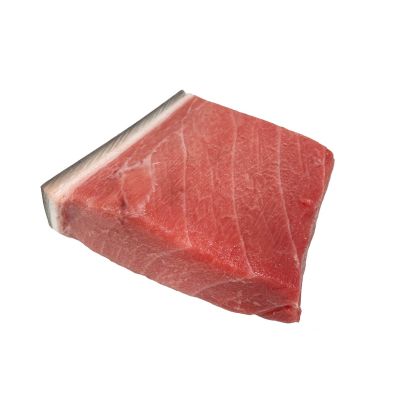 Bluefin Tuna 'Chutoro', Sashimi (Japan Grade), Saku Block, Frozen, +/-250g£31.95Bluefin tuna chutoro comes from the loin, one of the most popular parts of the fish. Chutoro is best eaten raw, in sushi and sashimi dishes, or ceviche. The chutoro has a pinker colour than akami, due to a higher level of fat. This 225g piece is a smaller portion of saku (the Japanese term for block...Out of stock
Bluefin Tuna 'Chutoro', Sashimi (Japan Grade), Saku Block, Frozen, +/-250g£31.95Bluefin tuna chutoro comes from the loin, one of the most popular parts of the fish. Chutoro is best eaten raw, in sushi and sashimi dishes, or ceviche. The chutoro has a pinker colour than akami, due to a higher level of fat. This 225g piece is a smaller portion of saku (the Japanese term for block...Out of stock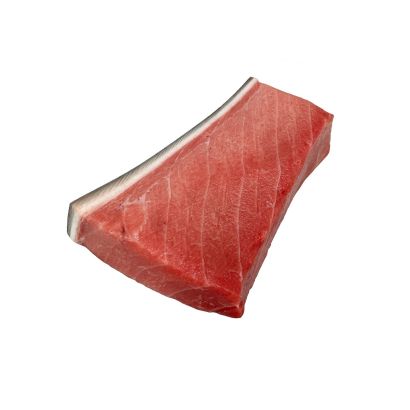 Bluefin Tuna 'Chutoro', Sashimi (Japan Grade), Saku Block, Frozen, +/-500g£59.95The chutoro is part of the loin, one of the most popular cuts of tuna. Chutoro is delicious eaten raw, in sushi or ceviche dishes. The chutoro has a more pink colour than akame, due to a higher level of fat. Bluefin is the largest of the tunas, and can reach up to 680kg in weight. Bluefin tuna is a...Out of stock
Bluefin Tuna 'Chutoro', Sashimi (Japan Grade), Saku Block, Frozen, +/-500g£59.95The chutoro is part of the loin, one of the most popular cuts of tuna. Chutoro is delicious eaten raw, in sushi or ceviche dishes. The chutoro has a more pink colour than akame, due to a higher level of fat. Bluefin is the largest of the tunas, and can reach up to 680kg in weight. Bluefin tuna is a...Out of stock
What makes bluefin tuna so special?
Our Japan-grade sashimi bluefin tuna is very special. The large Bluefin Tuna comes from the Mediterannean, after migrating from cold Antarctic waters. Our bluefin tuna products, known as atún rojo in Spain, are famous for their flavour and texture , which is incomparable to regular tuna. The huge bluefin tuna fish yields many different cuts, all with their own properties, textures and flavours. They are a highly sought-after species of fish due to their wide spectrum of health properties. Bluefin tuna fish are high in healthy omega-3 fatty acids and healthy polyunsaturated fatty acids, as well as a number of vitamins and high levels of biological value protein.
What is the process of harvesting bluefin tuna?
The bluefin tuna are wild and free in the North Atlantic, until Spring when they return to the Mediterranean to spawn. Here, they are captured using the sustainable purse-seine technique and are kept in large marine ranch enclosures.
They are kept in the marine ranch enclosures a couple of miles away from the coast so that their weight and body fat index can be measured for optimal consumption. Here, they are exclusively fed a plentiful, all-natural wild fish diet which is all additive and antibiotic-free. Divers go into the pools every day to hand-feed each fish 10% of their bodyweight in food per day. The fish that they are fed include anchovies, sardines, mackerel, cuttlefish and a variety of crustaceans, which all contribute to the prized fattiness that delivers such flavour, texture and marbling.
Due to this selective process, the flavour of the tuna is very similar to the wild winter tuna, despite being harvested.
When the bluefin tuna are at the optimum weight, fat content and flavour profile, the fish are selected and harvested using the ike jime method. This rapid-slaughter method of fish preparation is Japanese, in which the fish is put straight into ice, paralysed and the blood is drained. This method preserves with fish’s flavour and texture.
Once the fish have been harvested at sea, they are frozen on board at -70 degrees and stored at -60 degrees when on land, which makes the bluefin Japan sashimi grade.
What makes it sashimi?
This fish is graded as Japan-grade sashimi, as it is highly respected and demanded in Japan, the world’s sashimi and sushi capital. The super-freezing process preserves the properties of the fish as if it had just been taken from the sea. Some say that you can see the muscles move when they are thawed (the chijimi effect). The -60 degrees temperature allows the bluefin tuna to be eaten raw years after it has been super-frozen, as the high-quality texture and flavour are maintained, as well as any parasites being killed.
When the bluefin tuna is frozen, the deep red colour appears lighter, but as soon as it has been thawed, this returns to its’ original colour.
The purse-seine technique that is used to capture the tuna is designed for the non-capture of other smaller fish and additionally are allowed to naturally reproduce in the enclosures. The process is regulated with quotas, as well as a portion of the generated income going to fund scientific research to support the tuna species. The company that harvests the fish have full traceability and accreditation of each part of the fish sold, meaning that each fish can be traced, with a full record of microbiological analysis and fat content.
History of the Almadraba harvesting method
The Almadraba method of fishing is an ancient technique, from before the Roman times, in which nets are attached to both sides of the land off of the Strait of Gibraltar. The Almadraba is a form of Purse Seine fishing, in which a complex network of nets catch the large fish, but allow smaller fish to escape the nets (the mesh is a metre wide). Purse Seine nets never touch the bottom of the sea bed, making them more sustainable than a lot of regular fishing processes. Every day during the Spring migration period, the bluefin tuna are lifted in a ‘levanta’ to the top of the water in the nets.
The large bluefin tuna are caught in the nets, as they migrate from the Atlantic into the warmer Mediterranean in the Spring months of April and May, where the fish come to spawn. The annual migration of the bluefin tuna from the cold waters of the Atlantic, to the warmer waters of the Mediterranean, is so the fish can spawn.
Due to the huge demand for bluefin tuna internationally (thanks to the ever-increasing sushi culture), there are strict rules on how bluefin tuna can be harvested, as they were over farmed to the point of endangerment in the past.
Nowadays, there are few companies that are certified to catch tuna in this area and use this method, but those that do, take the tuna from the nets and move them to marine pens, where they are fed oily natural fish and monitored for the perfect fat content and size. They are also encouraged to reproduce here, which in turn has grown the population of bluefin tuna, with ever-increasing numbers since 2010. Moving them to marine pens means that the fish are available all year round, as suggests their title ‘wild-caught farm-raised’.
When the time comes, the bluefin tuna are slaughtered using the ike-jime method, filleted, and frozen to -60 degrees within ten minutes of leaving the water. The process is painless, and paralyses the fish instantly, avoiding the spread of lactic acid. This super quick-freezing process means that no quality, texture, or colour is lost, and the fish do not suffer ‘rigor mortis’, the seizing of muscles when killed.






